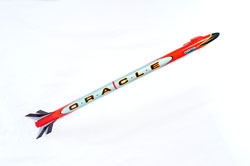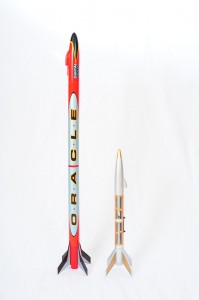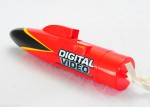
Estes Oracle Video Rocket

The Estes Oracle Video Rocket predates the recently launched (pun intended) Estes Astrovision by a few years. It was the first motion picture rocket offered by Estes since the Cineroc of the 1970’s.


The Oracle is tall, measuring in at about 3 feet tall, and is powered by a “D” sized rocket engine. By contrast, the Astrovision is only 19″ tall and is flown on the smaller “C” sized engine. Here is a photo of the two side by side illustrating the height differences.


The camera’s lens points out the side of the nose cone, and a mirror in an exterior streamlined shroud reflects the lens’ view towards the ground. Operating the camera is fairly simple. Prep the rocket for flight and place it on the launch pad. Turn on the camera using the power switch on the side and press the start button. A red light will go on and an audible “beep” will be heard. At this point, the camera is not recording, so you have time to get back to the launch button. The beep will increase in frequency and go to a solid tone, at which point the red light glows green. The camera is now recording, so LAUNCH!
You get about 30 seconds of video, which enough to capture both the ascent and decent stages of the flight; so pretty much the entire flight. The Oracle includes a parachute mount point on the nose of the camera, so you can have the camera pointing down during decent to capture the ground. The normal mounting point at the base of the camera will have the camera pointing up at the parachute during decent.
The Oracle can store only one flight video, so if you intend to fly it more than once AND capture video for each flight, bring a laptop with you to the flight field so you can offload the video using the supplied software and USB cable.
The Astrovision has replaced the now discontinued Oracle in the Estes product catalog, so you collectors had better grab one while they’re still available and cheap.
This is a video I took using my Oracle. Just after it launched, we launched an Estes Astrocam, so you can see it’s smoke trail in the upper left corner of the video image.
[wordbay]estes oracle[/wordbay]
Originally posted 2015-10-18 20:27:57.
2 comments
Leave a Reply
Archives
- April 2025
- March 2025
- February 2025
- January 2025
- December 2024
- November 2024
- October 2024
- September 2024
- August 2024
- July 2024
- June 2024
- May 2024
- April 2024
- March 2024
- February 2024
- January 2024
- November 2023
- October 2023
- September 2023
- August 2023
- July 2023
- April 2023
- March 2023
- September 2022
- September 2013
- August 2013
- March 2013
- September 2012
- June 2012
- December 2011
- August 2011
- July 2011
- May 2011
- March 2011
- January 2011
- December 2010
- November 2010
- September 2010
- August 2010
- July 2010
- June 2010
- April 2010
- March 2010
- February 2010
- January 2010
- December 2009
- November 2009
- October 2009
- September 2009
- August 2009
- July 2009
- June 2009
- May 2009
- April 2009
- March 2009
- February 2009
- January 2009
- December 2008
- November 2008
- October 2008
- September 2008
- August 2008
- July 2008
- June 2008
- May 2008
- April 2008
- March 2008
- February 2008
- January 2008
- December 2007
- November 2007
- October 2007
- September 2007
Thanks for showing the comparison – any thoughts on why the Oracle was such a large rocket. It really was great fun – I have a fantastic video from the first flight of my Oracle – I didn’t have much luck with videos after that as the USB port suffered some corrosion due to an unexpected ocean recovery…
The Oracle is large (i.e. long) for stability reasons given the weight of the camera. These days you can get much better video, with sound, from a ‘keychain’ video camera taped to the side of an ordinary model rocket.
http://www.rcgrabbag.com/archives/cheap-cinceroc-rocket-for-the-modern-age